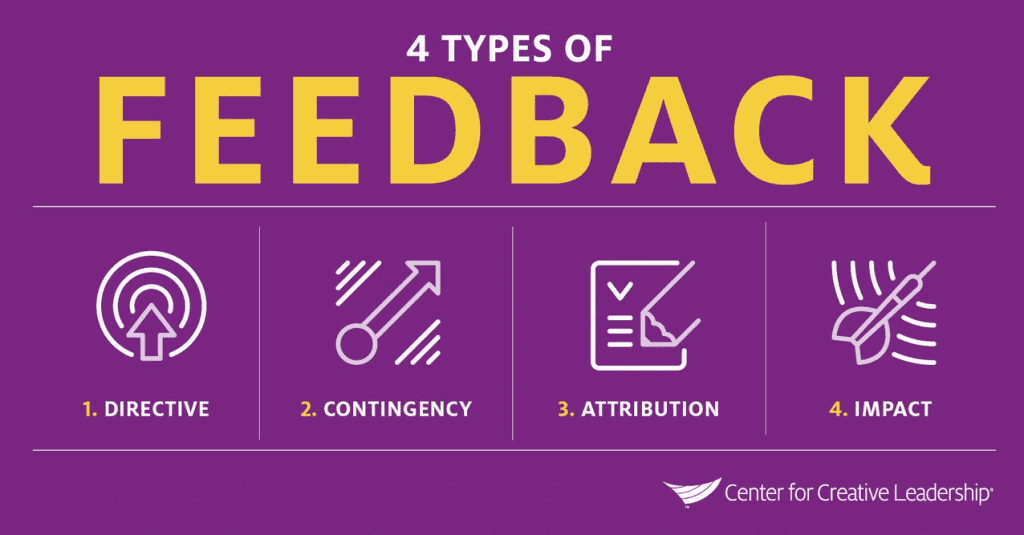For managers, giving and receiving feedback is a complex and delicate subject. Yet we tend to reduce different types of feedback to a simple binary of positive and negative. In one corner, we picture a drill sergeant screaming at new recruits. In the other, we picture a preschool teacher handing out gold stars, even to the kids finger-painting on the walls.
Chances are, your own management style falls somewhere between those two extremes, but it’s still essential to have a nuanced understanding of types of feedback. Effective leaders know how to give their reports a healthy mix of different kinds of feedback. Too much praise and your high-performing team members can get complacent, since they know you’ll love everything they do. Too much criticism and your struggling employees will get frustrated, since nothing is ever good enough.
Unfortunately, many managers struggle to give effective feedback. In fact, according to HBR, 63% of HR executives report that their single biggest performance management challenge is “managers’ inability or unwillingness to have difficult feedback discussions.”
To overcome that anxiety, and to expand your feedback toolkit, here are three feedback frameworks and the appropriate time and place for each.
Constructive Feedback
Hopefully, all the feedback you give your reports is constructive in the sense that it’s helpful. But “constructive feedback” in this context describes feedback that is focused on specific issues and backed up by evidence. This framework doesn’t just divide your comments into positive and negative. It emphasizes giving “feed-forward:” addressing future behavior as much as discussing what worked and what didn’t in the past.
Positive feedback: Praise for something someone has done
What it sounds like: “Great job on that report!”
When to give it: You should seize every opportunity to provide positive feedback in both formal and informal settings. But make a particular effort to hand out major kudos in public, in front of the rest of your team. Not only will it make your report proud, it’ll inspire the rest of the team to rise to that standard and earn some praise of their own.
Negative feedback: Criticism for something someone has done
What it sounds like: “That report was missing some of the nuance we’re looking for.”
When to give it: Stick with the managerial axiom of “praise in public, criticize in private.” When you have to point out the faults in someone’s work, do it in a private setting, like a direct message or a one-on-one meeting. Also, while you can’t control how anyone takes your feedback, you can prepare for their reaction. Imagine ahead of time multiple ways that your report might take this piece of criticism, and how you will respond to reaction.
Positive feed-forward: Affirming comments about future performance
What it sounds like: “I know this is your first report, but I’m confident you can handle it, given the skills you’ve already shown.”
When to give it: You might choose to do this in private if you’re asking a team member to take on a new responsibility and you want to give them a confidence booster. You might also publicly announce to the team how excited you are for a team member to take on a new role, and how well you expect them to do. It will serve as encouragement and act as an insurance policy to ensure they give it their all.
Want to be a better manager with a happier, healthier and more effective team?
Sign up for a free coaching consultation with Uptick Co-founder Chris Zaugg to improve your team’s effectiveness by connecting relationally.
Negative feed-forward: Critical comments about future performance
What it sounds like: “I know turning in work on time has been an issue for you, so make sure you plan this project carefully.”
When to give it: Again, this type of feedback should be issued in private, preferably in a one-on-one. That way, you the time to not only point out potential roadblocks, but discuss how to remove them. Remember to ground negative feed-forward in specifics. Advising someone to plan ahead gives them room to grow. But telling someone they are a poor planner is just discouraging, and worse, that type of criticism tends to become a self-fulfilling prophecy.
Self-Feedback
Asking your employees to evaluate their own performance is like playing with dynamite: It can make a road through a mountainside … or it can blow up in your face. For some employees, hearing praise or criticism just doesn’t make much of an impact, so having them assess their own work—out loud—can be more productive.

On the other hand, if you aren’t careful about choosing how you ask for self-feedback, your report will likely clam up. (There’s a reason everyone hates the self-evaluation section of a performance review.) The outcome all depends on whether or not you’ve made an employee comfortable enough to be candid.
What it sounds like: “How did it feel to do that project on your own?”
Asking for self-feedback in this way is much more effective than asking, “How do you think you did?” That question sounds like a test and will likely make your employee nervous. After all, they don’t want to seem overly confident by saying, “I nailed it,” and they don’t want to seem incompetent by pointing out all their mistakes. But asking how something felt lets an employee speak in less loaded terms. They’ll feel safer saying “I really enjoyed this part of the project,” or “I found this part challenging and stressful.”
You can also keep an eye on the future by asking, “What did you learn from this experience that you’ll use next time?” That way, an employee can point out their own growth areas, and managers don’t have to be the “bad guy.”
When to give it: To effectively draw out honest self-feedback, managers must create a safe environment where employees can be truly reflective. So this isn’t the type of conversation you can have around the water cooler. Instead, incorporate requests for self-feedback in one-on-one meetings, and make sure your body language and tone are inviting and encouraging. The richness of the self-feedback you get will be a direct reflection of how much your reports trust you.
Directive, Contingency, Attribution, and Impact Feedback
The Center for Creative Leadership divides feedback four ways, but it’s significantly different from the constructive feedback model. While that model is useful for managers who need to keep their comments grounded in specific issues and pointed toward the future, this one offers several ways you might frame the same issue. Managers can choose which one will be more effective in getting through to a particular employee.

Directive feedback
This essentially means telling a team member what you’d like them to do. As a manager, you should already be comfortable with it.
Positive directive feedback: “Your work looks solid! Go ahead and send it through the pipeline!”
Negative directive feedback: “I think you should start giving your work a final pass to check for errors before you send it for review.”
Contingency feedback
Contingency feedback takes the form of if/then statements, wherein you show what the future consequences of a behavior will be. If you struggle with having difficult conversations with employees, this technique is particularly useful. It allows you to lay out a situation in terms of simple cause and effect, instead of assigning blame.
Positive contingency feedback: “If you complete this training on time, you’ll be in line for promotion by next quarter.”
Negative contingency feedback: “If you continue to nap during meetings, you will be at risk for termination.”
Attribution feedback
As the name suggests, attribution feedback shies away from specifics and talks about someone in terms of their innate attributes. A major caveat with this one is that it should only be used for praise.
Positive attribution feedback: “I know you’re ready to lead this meeting because you’re such a good communicator.” (Employee perks up, aces meeting, and starts taking more leadership responsibilities.)
Negative attribution feedback: “Make sure you have detailed notes for the meeting since communication isn’t your strong suit.” (Employee wilts, botches meeting, and stops speaking up because they assume they communicate poorly.)
Impact feedback
Impact feedback talks about behavior in terms of how it impacts other people. It’s an especially effective form of feedback for employees who struggle to absorb other forms of criticism or praise. Like contingency feedback, it’s grounded not in labeling behavior as bad or good, but in illustrating its consequences.
Positive impact feedback: “When you saved the relationship with that customer, it meant we didn’t have to lay anybody off.”
Negative impact feedback: “When you didn’t tell anyone you were behind schedule, it pushed the whole project back, and everyone had to work overtime to catch up.”
Find the Right Types of Feedback for You and Your Team Members
We’ve been over several feedback models, so how will you know which one to employ? You can start by asking in your team members in your initial one-on-ones. Find out how they like to receive praise and criticism, and how important each one is to them. But improving your feedback game is also about knowing yourself: finding a style that will break you out of your comfort zone.
Remember, while it’s important to have challenging, critical dialogues, it’s equally important to call out good work. And while these frameworks give equal time to positive and negative feedback, your ratio of praise to criticism should always be weighted in favor of the positive.
At the end of the day, it’s all about having a variety of styles to choose from. That way, you can pick the most effective type of feedback for a given employee and a given situation. Experiment with techniques until you’ve found the right combination to motivate your team and decrease your anxiety.
(Look, you read the whole thing! Great job! You get a gold star!)
Want to be a better manager with a happier, healthier and more effective team?
Sign up for a free coaching consultation with Uptick Co-founder Chris Zaugg to improve your team’s effectiveness by connecting relationally.


